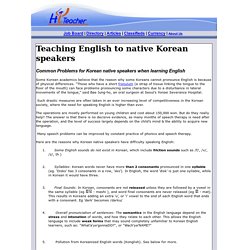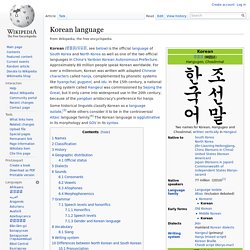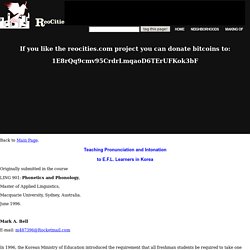

English pronunciation practice for Korean speakers. Hi Teacher. Some Korean academics believe that the reason why some Koreans cannot pronounce English is because of physical differences.

“Those who have a short frenulum (a strap of tissue linking the tongue to the floor of the mouth) can face problems pronouncing some characters due to a disturbance in lateral movements of the tongue,” said Bae Jung-ho, an oral surgeon at Seoul’s Yonsei Severance Hospital. Such drastic measures are often taken in an ever increasing level of competitiveness in the Korean society, where the need for speaking English is higher than ever.
The operations are mostly performed on young children and cost about 150,000 won. But do they really help? The answer is that there is no decisive evidence, as many months of speech therapy is need after the operation, and the level of success largely depends on the child’s mind & the ability to acquire new language. Many speech problems can be improved by constant practice of phonics and speech therapy. 1. 2. 3. 4. 5. Konglish 1. Korean language. Korean (한국어/조선말, see below) is the official language of South Korea and North Korea as well as one of the two official languages in China's Yanbian Korean Autonomous Prefecture.

Approximately 80 million people speak Korean worldwide. For over a millennium, Korean was written with adapted Chinese characters called hanja, complemented by phonetic systems like hyangchal, gugyeol, and idu. In the 15th century, a national writing system called Hangeul was commissioned by Sejong the Great, but it only came into widespread use in the 20th century, because of the yangban aristocracy's preference for hanja.
Some historical linguists classify Korean as a language isolate,[3] while others consider it to be in the controversial Altaic language family.[4] The Korean language is agglutinative in its morphology and SOV in its syntax. Names[edit] The Korean names for the language are based on the names for Korea used in North and South Korea. Classification[edit] History[edit] Why Korean and Japanese Students Can't Speak English. English pronunciation practice for Korean speakers. Teaching Pronunciation and Intonation. If you like the reocities.com project you can donate bitcoins to: 1E8rQq9cmv95CrdrLmqaoD6TErUFKok3bF Back to Main Page.

Teaching Pronunciation and Intonation to E.F.L. Learners in Korea Originally submitted in the course LING 901: Phonetics and Phonology, Master of Applied Linguistics, Macquarie University, Sydney, Australia. June 1996. Mark A. E-mail: m487396@Rocketmail.com In 1996, the Korean Ministry of Education introduced the requirement that all freshman students be required to take one year of basic English Language training. In our department, which was set up for the first time in February this year, there are currently sixteen instructors of English conversation.
All students in Korea receive training in English grammar and vocabulary from middle-school (Junior-High) onwards. All instructors are native speakers of English who have had at least some teaching experience in Korea or in their home countries. Several English consonant sounds do not exist in the Korean speech sound system.
Korean alphabet, pronunciation and language. Korean is spoken by about 63 million people in South Korea, North Korea, China, Japan, Uzbekistan, Kazakhstan and Russia.

The relationship between Korean and other languages is not known for sure, though some linguists believe it to be a member of the Altaic family of languages. Grammatically Korean is very similar to Japanese and about 70% of its vocabulary comes from Chinese. Origins of writing in Korea Chinese writing has been known in Korea for over 2,000 years. It was used widely during the Chinese occupation of northern Korea from 108 BC to 313 AD. The Idu system used a combination of Chinese characters together with special symbols to indicate Korean verb endings and other grammatical markers, and was used to in official and private documents for many centuries.
The Korean alphabet was invented in 1444 and promulgated it in 1446 during the reign of King Sejong (r.1418-1450), the fourth king of the Joseon Dynasty. Notable features of Hangeul The Hangeul alphabet (한글) Vowels (모음/母音)